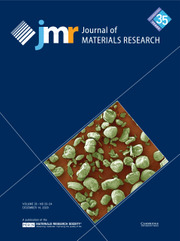Crossref Citations
This article has been cited by the following publications. This list is generated based on data provided by
Crossref.
Mody, N.R.
Hwang, R.Q.
Venka-taraman, S.
Angelo, J.E.
Norwood, D.P.
and
Gerberich, W.W.
1998.
Adhesion and fracture of tantalum nitride films.
Acta Materialia,
Vol. 46,
Issue. 2,
p.
585.
Mougin, J.
Galerie, A.
Dupeux, M.
Rosman, N.
Lucazeau, G.
Huntz, A.-M.
and
Antoni, L.
2002.
In-situ determination of growth and thermal stresses in chromia scales formed on a ferritic stainless steel.
Materials and Corrosion,
Vol. 53,
Issue. 7,
p.
486.
Riffard, F
Buscail, H
Caudron, E
Cueff, R
Issartel, C
and
Perrier, S
2003.
Yttrium sol–gel coating effects on the cyclic oxidation behaviour of 304 stainless steel.
Corrosion Science,
Vol. 45,
Issue. 12,
p.
2867.
Riffard, F.
Buscail, H.
Caudron, E.
Cueff, R.
Issartel, C.
and
Perrier, S.
2006.
The influence of implanted yttrium on the cyclic oxidation behaviour of 304 stainless steel.
Applied Surface Science,
Vol. 252,
Issue. 10,
p.
3697.
Wang, X.M.
Zeng, X.Q.
Wu, G.S.
Yao, S.S.
and
Li, L.B.
2007.
Oxidation kinetics of magnesium alloys treated by tantalum ions implantation.
Nuclear Instruments and Methods in Physics Research Section B: Beam Interactions with Materials and Atoms,
Vol. 263,
Issue. 2,
p.
401.
Chevalier, S.
2008.
Developments in High Temperature Corrosion and Protection of Materials.
p.
290.
Kemdehoundja, M.
Grosseau-Poussard, J. L.
and
Dinhut, J. F.
2009.
On the discrepancy between theoretical and experimental thermal stress in chromia oxide films.
Journal of Applied Physics,
Vol. 105,
Issue. 6,
Barnard, B. R.
Watkins, T. R.
and
Liaw, P. K.
2010.
An Evaluation of the Use of X-ray Residual Stress Determination as a Means of Characterizing Oxidation Damage of Nickel-Based, Cr2O3-Forming Superalloys Subjected to Various Oxidizing Conditions.
Oxidation of Metals,
Vol. 74,
Issue. 5-6,
p.
305.
Kemdehoundja, M.
Grosseau-Poussard, J.L.
and
Dinhut, J.F.
2010.
Raman microprobe spectroscopy measurements of residual stress distribution along blisters in Cr2O3 thin films.
Applied Surface Science,
Vol. 256,
Issue. 9,
p.
2719.
2010.
Oxide Scale Behavior in High Temperature Metal Processing.
p.
207.
Chevalier, S.
2010.
Shreir's Corrosion.
p.
132.
Chevalier, S.
2014.
What did we learn on the reactive element effect in chromia scale since Pfeil's patent?.
Materials and Corrosion,
Vol. 65,
Issue. 2,
p.
109.
Riffard, Frederic
Fondard, Jeremie
Moulin, Philippe
Perrier, Sebastien
and
Buscail, Henri
2014.
Lanthanum Effect on the Isothermal High Temperature Oxidation Behavior at 1,000 °C of a Phosphoric Acid-Treated AISI 304 Stainless Steel.
Oxidation of Metals,
Vol. 81,
Issue. 1-2,
p.
191.
Latu-Romain, L.
Parsa, Y.
Mathieu, S.
Vilasi, M.
and
Wouters, Y.
2018.
Chromia Scale Thermally Grown on Pure Chromium Under Controlled p(O2) Atmosphere: I. Spallation Investigation Using Photoelectrochemical Techniques at a Mesoscale.
Oxidation of Metals,
Vol. 90,
Issue. 3-4,
p.
255.
Iyer, Anand H.S.
Stiller, Krystyna
and
Colliander, Magnus Hörnqvist
2018.
Room temperature plasticity in thermally grown sub-micron oxide scales revealed by micro-cantilever bending.
Scripta Materialia,
Vol. 144,
Issue. ,
p.
9.
Ulrich, Anke S.
Kaiser, Timo
Ionescu, Emanuel
Riedel, Ralf
and
Galetz, Mathias C.
2019.
Reactive Element Effect Applied by Alloying and SiHfBCN Coating on the Oxidation of Pure Chromium.
Oxidation of Metals,
Vol. 92,
Issue. 3-4,
p.
281.
Petry, Nils-Christian
Bik, Maciej
Wilk, Łukasz
Swadźba, Radosław
Ulrich, Anke Silvia
Sitarz, Maciej
Lepple, Maren
and
Galetz, Mathias Christian
2023.
Polymer-derived SiAlOC coating to improve the high-temperature resistance of chromium.
Surface and Coatings Technology,
Vol. 474,
Issue. ,
p.
130049.
Reuban, Anicha
Chen, Jie
Povstugar, Ivan
Litnovsky, Andrey
Coenen, Jan Willem
Linsmeier, Christian
and
Gonzalez-Julian, Jesus
2024.
The Effect of Y Addition on Oxidation Resistance of Bulk W-Cr Alloys.
Materials,
Vol. 17,
Issue. 23,
p.
5749.

